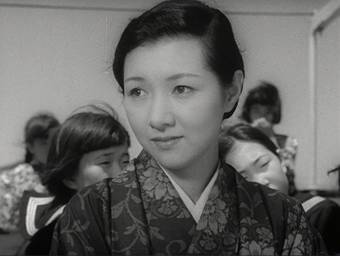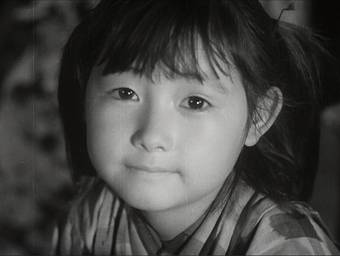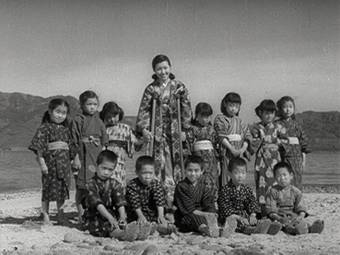|
I
have to admit to being only vaguely aware of Kinoshita Keisuke's
Nijushi no hitomi [Twenty-Four
Eyes] before the announcement of its UK DVD release
by Masters of Cinema. As a confirmed devotee of Japan and its cinema, I realise I should have
known all about the film and have seen it some time ago,
but there are only so many hours in the day and so
many films to see, and some of us have to make a living
as well. And, of course, I'm English. I mentioned the title
to a friend who grew up in rural post-war Japan and her
eyes lit up. "You've got it?" she asked eagerly.
She knew Sakae Tsuboi's original novel well, and though
she had never seen the film, she was aware of its fame. As well she
might be. Back in 1955, it won the Golden Globe for Best Foreign
Language Film, and Kinema Junpo magazine selected it as
the year's Best Film, beating – wait for it – Kurosawa Akira's Seven Samurai [Shichinin no Samurai] and Mizoguchi Kenji's Sanshō Dayū.
That's right, the Japanese film industry believed it was
an even better film than Seven Samurai,
one of my very favourite films. How the hell
is it that I hadn't seen this before?
Set
on the inland sea island of Shodoshima, the story kicks
off with the arrival of new schoolteacher Oishi to
an isolated coastal village. Treated with contempt by the
older locals for her city-influenced clothing
and because she rides a bicycle, (necessary to cover the considerable distance from her home to the school in
which she has been engaged to teach), Oishi nonetheless
quickly connects with the young students, who soon become
devoted to their new teacher.
Watching
the film with my friend was a surprisingly touching and,
for her, nostalgic experience. She sang merrily along to
all the children's songs and even supplied words for several
of the instrumental pieces. She recognised many of the activities
and pointed frequently at the screen with the delighted
cry "I used to do that!" She also provided an
insight into scenes that, as a western viewer, I would otherwise
not have fully appreciated. A good example is the
sequence in which the children are being taught the musical
scales by Oishi's more old-fashioned employer. In an attempt
to provide an English equivalent for the spoken (or rather
sung) Japanese, the subtitles translate "hi
hi hi, fu mi mi mi, ii ii ii mu ii" as the more familiar
"doh doh doh, rei mi mi, so so so lah so" But
it is the teacher's refusal to use this globally accepted
western equivalent that is key to the scene – it is of English
origin, not Japanese, and therefore at this time and in
this community is something to be rejected.

It
is this very attitude, of course, that prompts the initial
hostility to Oishi on her arrival in the community, dressed
in western-style clothing and riding a vehicular import,
a reflection of pre-war rural frustration at the encroachment
of western values into Japanese society, something that
had already taken serious root in the cities and larger
towns. The children have yet to learn such judgemental attitudes,
and Oishi is able to communicate with them almost from the
moment she steps into the classroom, encouraging a lively
response to questions, leading them in outdoor sing-alongs,
and calling them by their nicknames, which she writes in
the attendance register.
But
what starts as a tale of an outsider's battle against small
town prejudice soon considerably widens its scope and thematic concerns.
The relationship between Oishi and her students is used
to examine Japanese social and political history in the
period leading up to, during, and immediately following the
Second World War. The children in particular are at the
core of this, and in the first half are just
about the only characters photographed in close-up, something
Kinoshita uses beautifully to connect us to them as individuals.
These young hopefuls represent both traditional thinking
– the boys who dream only for fighting for the Emperor –
and the changing times to come, as with the girl who writes
in her 'Hopes for the Future' essay of a Japan in which
women have regular jobs, and by association equal standing
with their menfolk. In this telling scene, one girl is unable
to write anything at all, as imminent bankruptcy has left
her family bereft of optimism.
Fate
certainly deals all of them a tough hand in these turbulent
times, as one girl falls victim to tuberculosis, another
is sold by her family into servitude on the mainland, and
a third leaves the island when their family is evicted.
The boys fare no better. Enthusiastically going off to
war to fight for their emperor, not all are destined to
come back alive, and one of them returns robbed of his sight. Oishi
is equally fated. Accidentally injured when a student
prank that backfires, she is instantly disconnected from her job and her
students through her inability to ride her bicycle to the
school. She later takes up teaching again at the larger
consolidated school, but by now is becoming disillusioned
with her profession, almost branded a communist for attempting
to widen her students' knowledge of politics, and a coward
for her dismay over young lives wasted by war. Although
she verbally protests, she remains effectively powerless
throughout, anguishing over events that she is unable to
prevent or affect.

The
authenticity of the activities which my friend so cheerily
recognised is perhaps counterbalanced a little by some artistic
licence when it comes to the portrayal of Oishi. Sato Tadao,
generally regarded as Japan's foremost film critic (and
the one Joan Mellen references in the accompanying booklet),
described her as "an idealisation" and says "I
can't remember any primary school teachers like Miss Oishi.
Even if any such people had really existed then, they would
probably have been forced to resign."* Not that this
really matters. Oishi is very much a post-war creation,
a symbol of a strong pacifistic element in Japan that was
opposed to rearmament, but also a voice that speaks for
a generation of young men lost to war, and a plea for
peace to present and future societies.
In the accompanying
booklet, Joan Mellen states that the final scenes of
the film are moving but not sentimental and that the film
as a whole bears no trace of sentimentality. I'm not so convinced, and
Sato Tadao himself has accused the film of sentimentalising
the anti-war issue. There is a very real emotional power
to much of the film, but it too often seems to rely on characters bursting
into tears, especially Miss Oishi, who in the final scenes
barely makes an appearance in which she is not crying at one point,
something that lands her the nickname 'Cry Baby' from the new generation
of young pupils. Pushing it just a little further over the
edge is the almost Hollywood-esque use of emotive western
tunes such as Annie Laurie, Auld Lang Syne
and There's No Place Like Home, which can feel
a tug too far at the heart strings. This is well illustrated
in the scene in which the boys go off to war – as they depart,
it's the faces of the boys, heroically framed but emotionally
vulnerable, that give the scene its emotional power, not
Oishi's tears of sadness. (I should mention here that I'm
not in any way imune to the effects of emotional cinematic
manipulation, and blubbered uncontrollably at the end of
Isao Takahata's Grave of the Fireflies.)
But
there is still a so much here to admire and enjoy, not least
in the quality of the film-making and the scope of the story,
which provides a fascinating insight into a pivotal moment
in Japanese history, albeit from a post-war, humanist perspective.
There are some beautifully handled scenes, most of which
involve the children at various stages of growth and development,
from the editorial linking of names to faces when Oishi
looks over the children's calligraphy, to the long walk
the pupils embark on to see their injured teacher, a demonstration
of their unity and fortitude that ultimately results in
Oishi's acceptance into the community. The island landscapes,
often gorgeous in themselves, are as much a character in
the film as any of the children, and are as crucial to the
narrative as the dried fields, narrow paths and open waterways
of Shindo Kaneto's The
Naked Island, and scene after scene demonstrate
Kinoshita's extraordinary eye for composition and camera
placement, and his understanding of the power and pace of
editing.

For
the most part, Twenty-Four Eyes is handsome
cinema, an involving, ambitious and sometimes strikingly
made work that is both epic in reach and intimate in approach,
but whose effectiveness as a tear-jerker will depend on
your reaction to the surplus of in-film expressed emotion.
But better than Seven Samurai and Sansho
Dayu? Not quite, at least in my book. It is nonetheless
still held in extremely high regard in its native Japan
and in 1999 was selected by Japanese critics as one of the
ten best Japanese films of all time. I'll thus let my friend
have the last word on a work that she was able to relate
to so much of. "It was a really nice film," she
told me, "but I still preferred the book." Ain't
that so often the way.
Of
all their recent DVD releases, it's the ones sourced from
the Shochiku studio that seem to have given Masters of Cinema
the biggest headaches, in the main because of what seems
to be the shoddy condition of the prints they have been
given to work with. Twenty-Four Eyes is
in some ways no exception, with a great deal of visible
wear and tear, print damage, and brightness instability.
There are scratches and dust all over the place, but – and
this is a notable but – there has been a commendable attempt
to reduce the visibility of these imperfections, and a largely
successful one – although still present, they are nowhere
near as distracting as you might think. This is due in no
small part to the transfer's surprisingly fine level of
detail and sharpness and generally excellent contrast, lifting
the picture quality well above those on the MoC discs of
Scandal
and The Idiot.
There are a couple of night scenes in which the black levels
turn decidedly grey, but on the whole this is a very pleasing
restoration of seriously imperfect source material.
The
mono soundtrack shows its age, being a little fluffy in
places and accompanied by a little background hiss, but
is otherwise clear and free of alarming pops.
The optional English subtitles are activated by default.
Only
one on the disk itself, and that's a Gallery
of original Shochiku promotional material, and it's a substantial
collection, being something like 60 production photographs,
all in fine shape and all reproduced at a decent size.
No
Masters of Cinema release would be complete without an accompanying
Booklet, which here is of the
usual high standard, featuring quality reproductions of
stills from the film and a sizeable essay by Joan Mellen,
who is clearly a huge fan of the film and covers it in impressive
detail. She is not as smitten by the book as my friend,
it has to be said, though does usefully highlight some of
the key differences between it and the film.
Subjective
issues of sentimentality aside, this is a hugely impressive
work that has never been made available for home viewing
in the UK before, and so this DVD release is particularly
welcome. It should be essential viewing for anyone interested
in classic Japanese cinema, or just great cinematic storytelling.
And let's face it, not everyone is as cynical about cinematic
tearjerkers as I am, and judging from reaction across the
web, there's a reasonable chance that by the end you
may have a handkerchief to your face and be trying to convince
those around you that you have something in your eye.
Masters
of Cinema have worked small wonders with what is obviously
a less than ideal print, and despite the print damage the
contrast and detail are very good. Not many extras, but
the disc still comes warmly recommended.
*
Currents in Japanese Cinema by Sato Tadao, translated
by Gregory Barrett, 2nd printing, published by Kodansha
International Ltd, 1987.
The Japanese convention of surname first is used for Japanese names throughout this review.
|